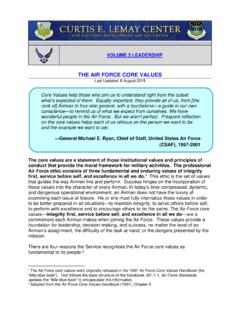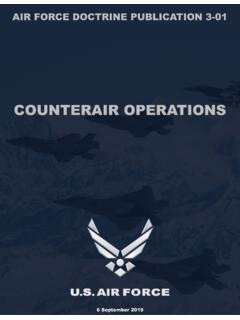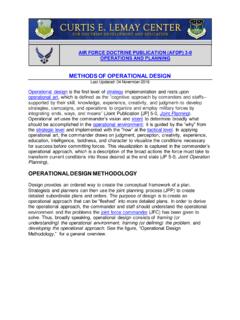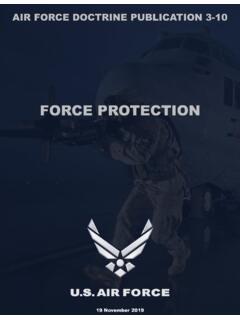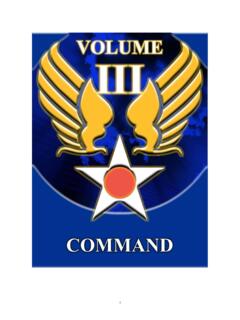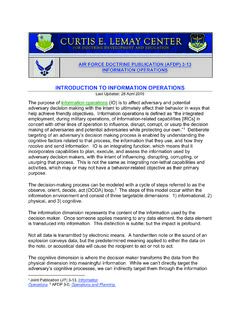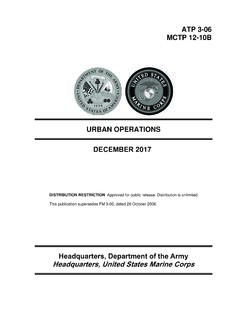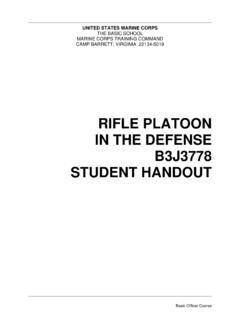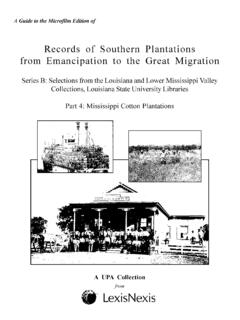Transcription of CSAF PERSPECTIVE ON DOCTRINE - U.S. Air Force Doctrine
1 CSAF PERSPECTIVE ON DOCTRINE Our Nation needs an Air Force that can fly, fight, and win as part of the joint team. Commanders must articulate intent and prepare to take the initiative in dynamic, contested environments. DOCTRINE offers an agreed upon, operationally relevant body of best practices and principles that articulates how we fight, captures our airpower experience, and guides how we operate within a joint Force . It provides a starting point, so we don t reinvent the wheel with every operation and allows us to continue to be the world s most capable Air Force . In today's complex global security environment, victory goes to the rapid integrator of ideas. These ideas are driven by training and the distilled knowledge all Airmen bring to the fight. I m relying on every Airman to innovate and incorporate concepts and technologies that will develop new best practices to shape future DOCTRINE .
2 We must prioritize and make difficult choices as we field a lethal, resilient, and rapidly adapting joint Force . Leaders must push decisions to the lowest competent, capable level using DOCTRINE as a foundation for sound choices. DOCTRINE is an opportunity to educate, empower, and prepare for the future fight. It guides us, but does not bind us. I m relying on every Airman to understand the lessons of DOCTRINE , and then draw on them to innovate and incorporate concepts and technologies that will develop new best practices to shape future DOCTRINE . This is how we solve difficult problems, make necessary changes, and how we accelerate change in our Air Force . The tools in DOCTRINE provide an excellent opportunity to build our foundation for future Airmen and forge unbeatable airpower for our Nation.
3 Airmen should read, understand, contemplate, and prepare for the full spectrum of operations, from competition to armed conflict. Never forget General LeMay s words: At the very heart of warfare lies DOCTRINE . CHARLES Q. BROWN, JR. General, USAF Chief of Staff, United States Air Force XX MONTH YEAR PREFACE Air Force DOCTRINE is the extant and emerging best practices in the application of airpower. DOCTRINE describes the operations and activities that create convergence of effects across the competition continuum. DOCTRINE is organized as basic, operational, and tactical level DOCTRINE . Basic DOCTRINE states the most fundamental and enduring beliefs describing airpower and the Airman s PERSPECTIVE . Operational DOCTRINE describes more detailed organization of forces and applies the principles of basic DOCTRINE to military actions.
4 Tactical DOCTRINE is contained in Air Force and Multi-Service tactics , Techniques, and Procedures publications. Blue underlined text denotes a hyperlink to another source document, normally Air Force or joint operational DOCTRINE , for additional discussion. Air Force DOCTRINE Publication (AFDP) 1, The Air Force , forms the basis of our Service culture. It defines airpower, as the ability to project military power through control and exploitation in, from and through the air. Airpower is employed to achieve joint Force commander (JFC) objectives in support of the National Defense Strategy (NDS). AFDP 1 addresses four fundamental topics: Why We Fight - War: our foundational purpose as a Service. Who We Are - Airmen: our values. What We Do - Airpower: airpower fundamentals and PERSPECTIVE .
5 How We Do It - Tenets of Airpower: airpower employment considerations. Ideas presented here enable Airmen to describe what the Air Force provides to joint all-domain operations (JADO). Air Force DOCTRINE Publication 1, The Air Force Table of Contents Chapter 1 WHY WE FIGHT: WAR .. 1 NATURE OF WAR .. 1 LEVELS OF WARFARE .. 1 AIRPOWER IN THE COMPETITION CONTINUUM .. 2 NATIONAL DEFENSE STRATEGY & OBJECTIVES .. 2 Chapter 2 WHO WE ARE: AIRMEN .. 4 Chapter 3 WHAT WE DO: AIRPOWER .. 6 DESCRIPTION OF AIRPOWER .. 6 FOUNDATIONS OF AIRPOWER .. 7 AIRPOWER FROM AN AIRMAN S PERSPECTIVE .. 8 Chapter 4 HOW WE DO IT: TENETS OF AIRPOWER .. 11 MISSION COMMAND .. 12 SYNERGISTIC EFFECTS .. 14 PERSISTENCE .. 15 CONCENTRATION .. 15 PRIORITY .. 15 BALANCE .. 15 CONCLUSION .. 16 Air Force DOCTRINE Publication 1, The Air Force 1 Chapter 1 WHY WE FIGHT: WAR NATURE OF WAR War is one of the means used by nation-states, sub-national groups, or supranational groups to achieve their objectives.
6 Conducting war from the air underpins the reason for the Air Force s existence. Airpower is an instrument of national power and can be employed in warfare. There are three basic truths that the Air Force believes are fundamental to warfare: War is an extension of politics by other means. War has been described as a violent clash of interests characterized by the use of Force . The Air Force conducts warfare as an extension of our national policy. War is a complex and chaotic human endeavor. Uncertainty and unpredictability, sometimes called the fog of war , combine to create what Clausewitz called friction which makes simple operations unexpectedly, and sometimes even insurmountably, difficult. The tenets of airpower help Airmen apply airpower effectively within this environment.
7 War is a clash of opposing wills. War is a collision of two or more forces, producing a dynamic interplay of action and reaction. The will of the people and the character of their leaders are critical components of warfare. Sound DOCTRINE , good leadership, effective organization, moral values, and realistic training can reduce the effects of uncertainty, unpredictability, and unreliability present in war. LEVELS OF WARFARE Airpower creates effects across all three levels of warfare: strategic, operational, and tactical. The strategic level of war defines why and with what the conflict occurs. The operational level of war determines what courses of action, in what order, and for what In our victory over Japan, airpower was unquestionably decisive. That the planned invasion of the Japanese Home islands was unnecessary is clear evidence that airpower has evolved into a Force in war co-equal with land and sea power, decisive in its own right and worthy of the faith of its prophets.
8 General Carl A. Spaatz, 1st Chief of Staff, United States Air Force Air Force DOCTRINE Publication 1, The Air Force 2 duration forces are employed in the conflict. Finally, the tactical level of war defines how we create the operational effects. Actions in war occur at the tactical level, but an understanding of the operational and strategic implications of those actions is key to the employment of airpower in pursuit of our national objectives. AIRPOWER IN THE COMPETITION CONTINUUM The Air Force employs forces in pursuit of our national objectives across the competition continuum. Rather than the traditional binary classifications of peace and war, the competition continuum describes a world of enduring competition conducted through a mixture of cooperation, competition below armed conflict, and armed conflict.
9 The Air Force creates effects across the continuum through the conduct of operations, military engagement, security cooperation, deterrence, and other activities. For detailed discussion on the competition continuum, see Joint DOCTRINE Note 1-19, Competition Continuum, 3 June 2019. NATIONAL DEFENSE STRATEGY & OBJECTIVES The National Defense Strategy sets the context in which Airmen must anticipate and plan across the competition continuum. Long-term strategic competition and the expansion of our adversary s military capabilities threaten the United States prosperity Air Force DOCTRINE Publication 1, The Air Force 3 and security. Joint Force operations are increasingly interconnected, interdependent, and challenged. Our adversary s anti-access and area denial focus and proliferation of advanced technologies create contested environments that reduce airpower s ability to conduct global operations across the competition continuum, reduce freedom of maneuver, and challenge the Air Force s ability to operate.
10 This operating environment requires examining how forces will sense, plan, decide, and act in concert across all domains. The National Defense Strategy delivers the framework that defines the Department of the Air Force s functions. The Air Force , as part of the Department of the Air Force , provides the Nation with global vigilance, global reach, and global power. Service DOCTRINE describes how to fulfill that responsibility. Global Vigilance is the ability to gain and maintain awareness anywhere; to provide warning and to determine intent, opportunity, capability, or vulnerability; then to fuse this information with data received from other Services or agencies and use and share relevant information with the joint Force commander (JFC). Global Reach is the ability to project military capability responsively with unsurpassed velocity and precision anywhere, and provide mobility to rapidly supply, position, or reposition joint forces.


